"In the beginning was the void and formlessness, mysterious, dark and grey... out of the chaos the painter brought form, created by the contrast of dark and light."
Paint Project: Separate Light From Darkness; Paint Something Round
Subject: Paint an Egg (or an apple, or a lightbulb, etc.)
Our Teacher & Guide: The Master of Shadow & Mystery... Leonardo
Creation Myth: Genesis, the beginning:
First The Creator made heaven & earth. The earth was without form and void,
and darkness was upon the face of the deep; and the Spirit of The Creator was
moving over the face of the waters. And The Creator said, "Let there be light";
and there was light. And The Creator saw that the light was good; and The
Creator separated the light from the darkness.
For our beginning we'll be using a monochromatic pallete, so you can find out just how much color there is in the least amount of color. Take Paynes grey and White.
(don't panic!! you can use black and white, burnt sienna and naples yellow, raw umber and parchment white, or graphite gray and white, or any really dark color and really light color. Stay away from complimentary colors to begin with, unless you just must use deep hooker's green and light pink... If you must, then you must... But our Creator in the myth above didn't get around to color for a few days.)
In the creation myth above you'll see that the Creator began with formlessness and void, darkness was on the face of the deep.
How we'll interpret that here is that your canvas begins with formlessness -- grey.
Mix a Middle Gray
On your pallete on one side put a nice big pile of white, on the other side a nice big pile of paynes gray or black, and in between them mix a pile that is half white, half black.. to a grey that is just between them in value... not too dark, not too light.
Take time in this step. Mix a good pile of paint that is middle gray. Put it right in the middle between your black paint and your white paint.
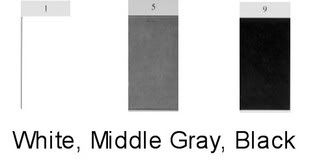
Later we'll mix other piles midway between these first three piles, giving five total values.
Black, Dark Gray, Middle Gray, Light Gray, White

Step One:
So mix a grey that's midway between your darkest dark and your lightest light, and prime your canvas with that.
I like to prime my canvas loosely, rather than one flat color, and I use a brush and a kitchen sponge. I use sponges during the painting to wipe stuff out, to create texture, to blend tones. Sometimes I use my fingers as well, to blend, to paint, to rub in areas.
After I have toned my canvas with middle gray, I use a soft charcoal pencil to sketch in loosely.
All the following stages took about 10 minutes each.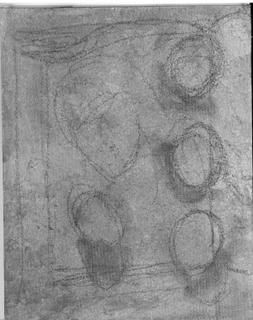
My subject is four eggs and a fork on an open book of DaVinci's drawings
I've toned the canvas, and drawn in a very sketchy manner the forms of the objects.
Step Two:
Establish some of the dark areas and some of the light areas. Now you're coming out of the chaos into order... let there be light... and let there be dark to contrast with it.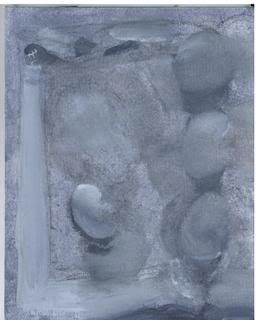
Out of the middle grey I've established some the darkest darks and some of the lightest lights. If you can't tell, squint your eyes at your subject... the darks and lights will pop out.
Mix grays between your piles of paint, so you now have five values from white to black.
Black, Dark Gray, Middle Gray, Light Gray, White
It's really important to keep your brushes clean. Don't mix colors with your brush, use a pallete knife, or a small putty knife. Trying to paint color into color to mix color on your canvas at this point will get muddy results
Step Three:
Continue to develop your forms and refine your drawing.
I've continued to develop the forms, but an egg has gone missing. The angle of the book edge on the left has changed as well. Because I started very sketchy, and didn't take a lot of time with the drawing, I've now found that I need to go back and really study what goes where and how. Not a major disaster if you're willing to work it through.
Form is in the Shadows
Leonardo wrote SIX BOOKS on Shadows. He considered development of shadows as the primary means to describe form.
Shadow is the obstruction of light. Shadows appear to me to be of supreme importance in perspective, because, without them opaque and solid bodies will be ill defined; that which is contained within their outlines and their boundaries themselves will be ill-understood unless they are shown against a background of a different tone from themselves. And therefore in my first proposition concerning shadow I state that every opaque body is surrounded and its whole surface enveloped in shadow and light. And on this proposition I build up the first Book. Besides this, shadows have in themselves various degrees of darkness, because they are caused by the absence of a variable amount of the luminous rays; and these I call Primary shadows because they are the first, and inseparable from the object to which they belong. And on this I will found my second Book. From these primary shadows there result certain shaded rays which are diffused through the atmosphere and these vary in character according to that of the primary shadows whence they are derived. I shall therefore call these shadows Derived shadows because they are produced by other shadows; and the third Book will treat of these. Again these derived shadows, where they are intercepted by various objects, produce effects as various as the places where they are cast and of this I will treat in the fourth Book. And since all round the derived shadows, where the derived shadows are intercepted, there is always a space where the light falls and by reflected dispersion is thrown back towards its cause, it meets the original shadow and mingles with it and modifies it somewhat in its nature; and on this I will compose my fifth Book. Besides this, in the sixth Book I will investigate the many and various diversities of reflections resulting from these rays which will modify the original [shadow] by [imparting] some of the various colours from the different objects whence these reflected rays are derived. Again, the seventh Book will treat of the various distances that may exist between the spot where the reflected rays fall and that where they originate, and the various shades of colour which they will acquire in falling on opaque bodies.
Leonardo da Vinci
The Notebooks
The more you work to develop the shadow side of your egg or round object, and explore the cast shadow, the more I think you will come to appreciate and understand why Leonardo, the master of shadow and mystery, considered shadows to be of the greatest importance in building form.
Work in the shadows to create form and light.
Step Four:
Continue to develop form, drawing, value, and texture. Pay attention to the edges of objects... where are they hard and clear, where are they diffused and softer? Shadows are diffused and softer. Pay attention to the light reflected shadow on the bottom of objects on the dark side of them, the side away from the light. Painting this reflected light will make the forms more real looking.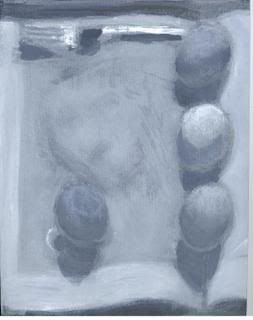
There, I've found the missing egg. I've also corrected the axis' of all the eggs so they're pointing the right way. I've three brown eggs and one white, so the tonal relationships are going to be really important.
Step Five:
Try to bring your painting together by developing the whole thing. Foreground, subject, and background should all be developed.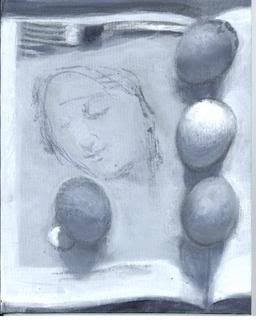
From here on in, the devil is in the details. I'm not fretting so much about the daVinci drawing as I am the tone of that leftmost egg. That circle shape underneath it is a quarter I used to balance it on the book.
_________________________________
OK, now paint an egg. If you want paint several eggs. Use black and white to do it. Keep the size of your painting about 8x10 inches.
When you're halfway through scan (or use a digital camera) your results and show them to the group... this way we can all learn from what each other is doing.
When you're finished, or nearly there, scan (or use a digital camera) your results and put them up. It's okay if it takes you all week. Just make a start.
_______
If I can answer any questions, or if I haven't made myself clear, or if you wish to critique my "Eggs on Leonardo," I'll be happy to hear what you have to say. But most of all I'd be happy to see your egg paintings. Have fun!!

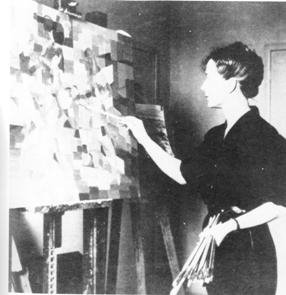













No comments:
Post a Comment